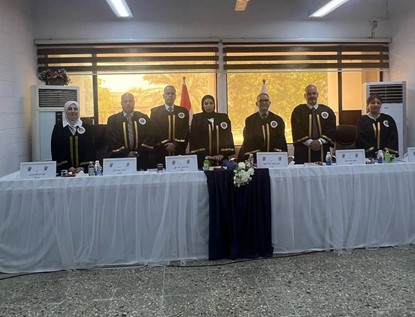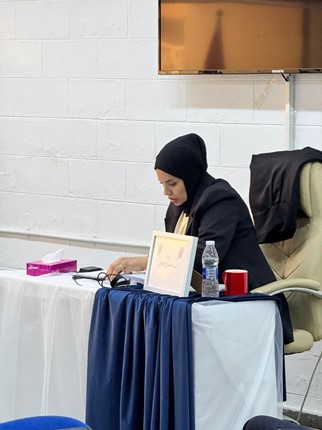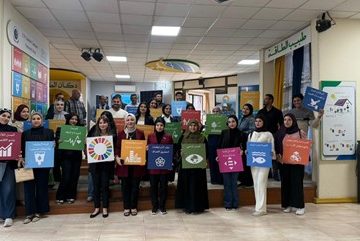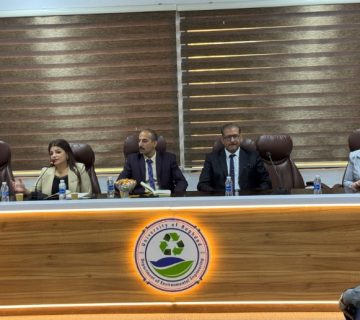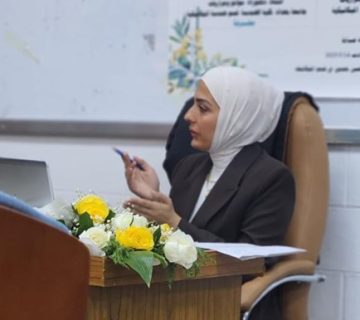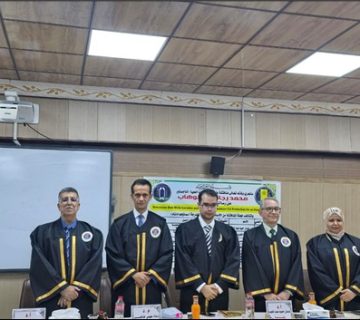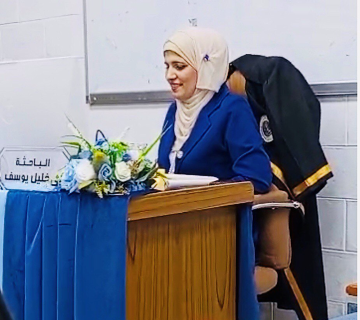Environmental Engineering Department at the College of Engineering, University of Baghdad, held PhD dissertation examination titled:
“Evaluation of Photo Catalysis Process for the Degradation of Sulfosulfuron Pesticide Contaminated Water”
By the student Israa Sabah Abbas and supervised Prof.Dr. Abeer Ibrahim Musa on Tuesday 13/5/2025, in the Environmental Engineering discussion hall. The examination committee consisted of Prof.Dr. Ghasan Hameed Abd AlMajeed as Chairman, and the membership of Prof.Dr. Muhanned Jasim Mohammed Ridha, Prof.Dr. Zyad Tariq Abd Ali, Assist.Prof.Dr. Hussien Majeed Faleeh and Assist.Prof.Dr. Tamara Kawther Hussein. After conducting the public discussion and listening to the student’s defense, the dissertation was accepted. It was summarized as follows:
The presence of emerging contaminants in recent decades, especially pesticides in water resources adversely affect both the ecosystems and humans. For that, the present study investigated the performance of sulfosulfuron pesticide degradation in aqueous solutions, has been studied to be removed by using an advanced oxidation process using two photocatalytic; one green synthesis catalyst ZnO using Olea europaea leaf extract, and the other was the heterojunction rGO/Fe3O4/Bi2S3/MgZnO nanocomposite. Batch and continuous experiments were conducted in the presence of visible light as irradiation. The obtained photocatalysts were well categorized by characterized using various techniques such as XRD, FTIR, SEM, AFM, TEM, VSM, DRS, PL, BET, EDS mapping, GC-MS, TOC, COD, and UV-vis spectroscopy. The influence of different variables pH in the range of (3, 5, 7, 8, 9 and 11), three different visible light intensities 39.8, 79.6 and 159.2 mW/cm2, and initial concentration of pesticide in the range of (10-80) mg/L, catalyst dose in the range of (0.5-2) g/L, and their relationship with the degradation efficiency were studied firstly in batch mode. The experimental results showed that the removal efficiencies were evaluated to be 82.08%, and 97.35% for ZnO, and rGO/Fe3O4/Bi2S3/MgZnO, respectively at the best conditions of catalyst dosage1 g/L, 10 mg/L sulfosulfuron concentration in 90 min reaction time, while the pH was 6.8, and 4.7, respectively. The investigation indicated that the photodegradation sulfosulfuron action showed greatly decreased upon the addition of the benzoquinone (BQ) scavenger (•O2−) (22.51%) which means the effect of the oxidant can be demanded for rGO/Fe3O4/Bi2S3/MgZnO, while the ZnO photodegradation activity throughout the sulfosulfuron was dramatically reduced (19.9%) upon the addition of the isopropanol (IPA) scavenger (•OH) as a result, the order of the oxidant’s influence. Importantly, the synthesized nanocomposite demonstrated excellent reusability with a removal efficiency of 71.23% after the fifth cycle of rGO/Fe3O4/Bi2S3/MgZnO degradation and 58.97% of ZnO. The results showed that the pseudo first order kinetic model best fits the data at the best conditions. For a continuous system, three operating variables were studied which were the flow rate, sulfosulfuron concentration, and the intensity of light. The best flow rate was 250 ml/min at 10 mg/l sulfosulfuron concentration with a maximum removal efficiency of 79.6%, and 93.5% at 180 min for green synthesis ZnO, and rGO/Fe3O4/Bi2S3/MgZnO, respectively. In conclusion, the biosynthesis methods for producing nanoparticle naturally are proven to be environmentally friendly way, effective for pesticide degradation which can be used as an alternative to the commercial, and the heterojunction rGO/Fe3O4/Bi2S3/MgZnO it has the highest efficiency and highest capacity in treating pesticides as seen in the results of GC-MS.
The recommendations of this dissertation:
- Real pesticides wastewater can be used instead of simulated wastewater.
- Studying the capability of photocatalysis process for treating the pesticides using sunlight irradiation system.
- Investigating the photocatalytic degradation activity against other pesticides pollutants such as organophosphorus, tribenuron methyl and chlortoluron.
- Synthesis heterojunction systems with different semiconductor deposition ratios and examine the improvement in the system characteristics and degradation efficiency.
- Investigating the effect of other operating parameters such as dissolved oxygen, reaction temperature, wavelength, inorganic salt, etc.
- Using examination devices from within the university or from any lab. In Iraq for the purpose of supervising the samples in order to avoid errors, such as sample damage or results that are far from logical.

